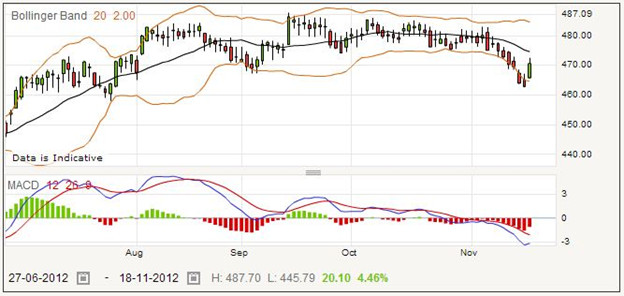Scottish Mortgage Investment Trust is a publicly listed investment trust, and is managed by Baillie Gifford & Co., investment managers based in Edinburgh. Looking at the daily price chart below, you can see that there is a fair degree of volatility as evidenced by the length of the candlesticks and by the fluctuating price, which makes this stock a good choice for spread betting by those experienced enough to handle it.

The trust started over one hundred years ago, and was first created to lend money to rubber plantations, following the demand for rubber for new cars such as the Model T Ford in 1907. Baillie and Gifford established the company to take advantage of the crisis. However, within a few years the crisis was over and the trust included bond and equity markets in its investments. It has always been international and flexibly managed, with no particular quotas for country or market sector of the investments.
Instead, the managers invest the shareholders’ money in whatever they consider to be the best opportunities, while still being subject to the Board’s regular review of the diversity of the holdings. In the 1960s, the Trust was an early investor in Japan when those markets were opened to foreigners, despite the continuing wartime memories; and in the 1970s the Trust steered away from UK stocks and bonds in the declining economy.
The Trust is said to operate with a five-year perspective, and aims to be a low cost investment trust. Looking at the price chart above, you can see a reasonable degree of fluctuation, although the trends are short lived. It might work out better to consider spread trading these shares on a shorter period to take advantage of the daily trading range, and you should be sure to test your trading strategy before entering your bet.
Scottish Mortgage Investment Trust Rolling Daily: How to Spread Bet on Scottish Mortgage Investment Trust Shares?
How well Scottish Mortgage Investment Trust performs depends on the managers, and in this case the trust managers are Baillie Gifford with more than a century of experience. However, this does not mean that the shares will always increase in value, so you should perform your technical analysis as usual. The current quotation for a rolling daily bet is 469.82 – 472.18, and if you think the price is going up you could place a bet for £5 per point at the buying price of 472.18.
As a first example, assume that the price goes up as you had hoped, and that you can close your spread bet for a profit when the quote is 495.67 – 498.03. The starting price was 472.18, and the closing price is 495.67. 495.67 minus 472.18 is 23.49 points. Multiplying by your stake of £5 per point, your total profit is £117.45. As this is a rolling daily bet, your account may have been charged a little each evening while the bet was open, but this is usually not a significant amount.
Secondly, consider the losing case. Perhaps the price went down after you placed the bet, and you cut your losses when the quote was 454.31 – 456.67. The closing price this time is 454.31, and the difference from your starting price is 17.87 points. For your chosen size of stake, that amounts to a loss of £89.35.
Many spread betters find that they do not have the time to watch the market during the day, so they are glad to use a stop loss order to help reduce the amount that they might lose. With a stop loss order, this time you might have found that the bet would close when the price dropped to 459.10 – 461.46. The bet opened at 472.18, as before, and this time closed at 459.10. That amounts to a loss of 13.08 points, and that would cost you £65.40 for your size of wager.
Scottish Mortgage Investment Trust Quarterly Futures
A quarterly futures spread bet does not involve rollover charges for a long position, as the daily bet does, and therefore some spread traders prefer it for medium-term bets. The current price for a far quarter bet on Scottish Mortgage is 470.87 – 476.55. Let’s say that you decide on a long position, staking £8.50 per point.
If the price rises to 502.65 – 508.21, you might decide to cash in, closing your bet and collecting your winnings. Your bet was placed at a starting price of 476.55. The bet closed at a price of 502.65. That means that you gained 502.65 minus 476.55 points, which is 26.10 points. For a stake of £8.50 per point, that gives you a profit of £221.85.
Some of the time your bets will not succeed. Suppose that the price fell after you placed your bet, and that you decided to close it and cut your losses when the price went down to 453.55 – 459.20. While the bet opened at 476.55, as before, this time it closed at 453.55. 476.55 less 453.55 is 23.00 points. Multiplying by your wager size of £8.50, your total loss amounts to £195.50.
Many spread betters decide to place a stop loss order when they take out a bet. In fact, some spread betting providers include the stop loss instruction on the betting dialog box so that it is easy to use. The stop loss order means that you will never forget to check the price and close a losing trade, as your spread betting company will close the trade for you. Suppose with a stop loss order this trade finished when the price went down to 458.22 – 463.85. With a starting price of 476.55 and a closing price of 458.22, you would have lost 18.33 points. This would amount to a loss of £155.81 on this particular bet.